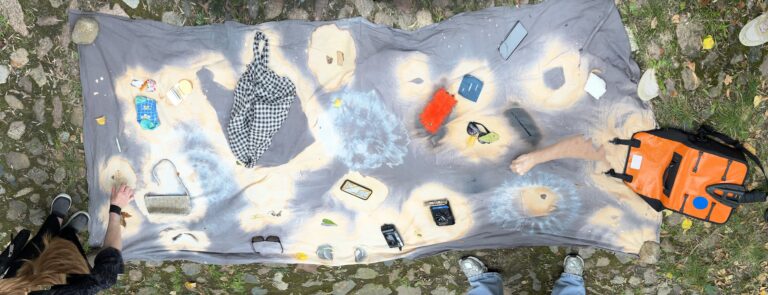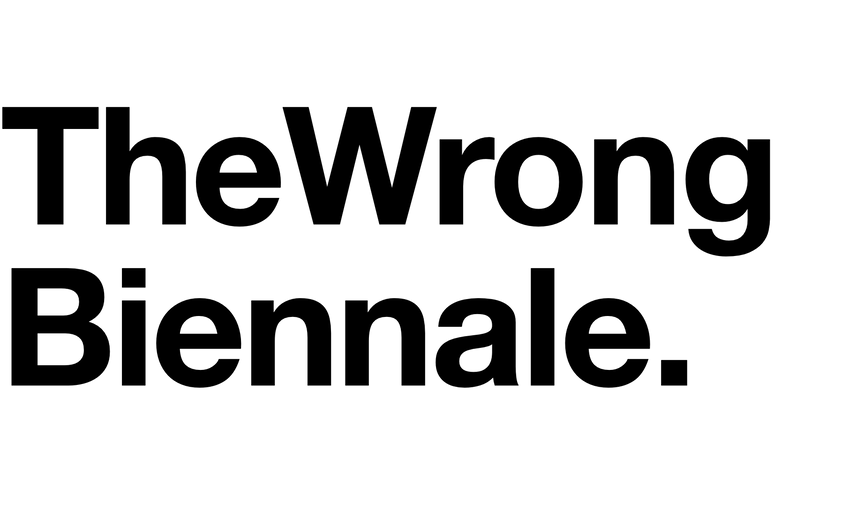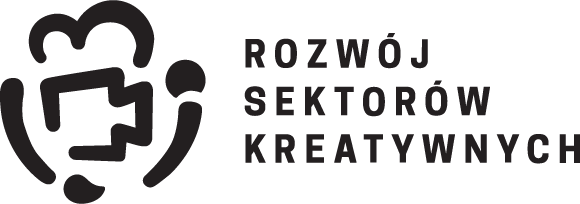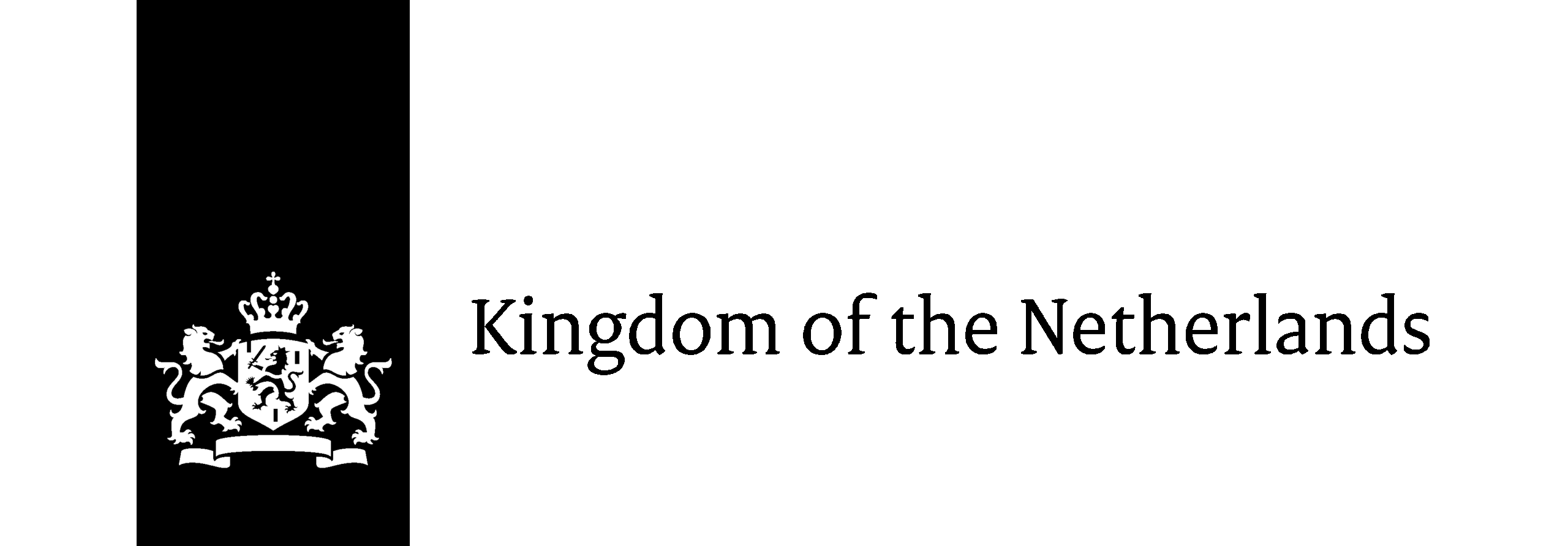Imagine scrolling through your feed: a viral dance, a political meme, a protest image, a breakfast snapshot. These fragments do not stand alone. Together they form a membrane, a living entity that we continuously shape, remix, and transform.
In this lecture, Roosje Klap explores the digital landscape as a site of sympoiesis—a concept borrowed from Donna Haraway, meaning “making with others.” Where the traditional artistic canon celebrated the singular genius (autopoiesis, or self-making), today’s digital culture emphasizes co-creation, decentralization, and collective authorship.
Drawing on her practice as a designer, researcher, and director of Noorderlicht, Klap reflects on how open-source remix culture, “anarchiving,” and the agency of non-human actors such as AI reshape our understanding of authorship and ownership. Projects like LAWKI serve as case studies for this transformation: demonstrating how humans, machines, and erased knowledges converge to create new, shared narratives.
The lecture addresses key questions:
– How do non-human participants influence creative processes?
– What does authorship mean in an age of infinite remix?
– Can slowing down the digital stream help us resist the speed and profit-driven logic of Big Tech?
Klap argues for a shift from “move fast and break things” toward “slow down and heal things.” By embracing radical plurality, we may uncover a common world built not on singular truths, but on diverse, entangled contributions.
Roosje Klap (she/her) is a dynamic researcher and mixed-media artist who investigates the experimental boundaries of custom-fit design through collaborations with artists, curators, architects, designers, and writers. With her collective ARK (Atelier Roosje Klap), she engages in a hybrid method of exchanging knowledge and developing work that reflects the group's artistic ambition to make modern technologies open-ended, inclusive, and fair spaces of participation.
Effective May 1, 2024, Klap was appointed director of Noorderlicht, a photography and lens-based media platform. Noorderlicht operates at the intersection of artistic experiment and social urgency, addressing issues such as the relationship between humans and nature and the distribution of power and economy. Initially focused on photography, Noorderlicht has expanded its scope to include all lens-based media. Noorderlicht runs an educational program, a publishing house, and its own Canson-certified print lab.
Roosje is a dedicated educator and coach. Specializing in design, media art, and digital humanities, Klap has designed curricula and led workshops for art academies and universities worldwide. Her guidance, knowledge and passion for creativity and inspiration have helped foster equitable relationships in their environments.
We are wrapping up this year’s edition with a great closing conference — coming soon online on Future Fragments.
Featuring: Krzysztof Pijarski, Kuba Dębczyński, Kuba Kulesza, Natalia Korczakowska, Jan Sowa, Katarzyna Nestorowicz, Andrzej Marzec, and Natalia Juchniewicz.
An initiative dedicated to exploring the concept of intelligence and the impact of technology on our future. Intelligence is no longer seen as a fixed attribute of individuals, but as an emergent, relational phenomenon—unfolding through interactions among organisms, systems, and environments. Similarly, we don’t think about technology as man’s creation opposed to nature, but rather as another layer of the planetary ecosystem in which we live. As intelligence and technology continue to evolve, both in human and nonhuman forms, so too must our understanding of their essence and influence. Future Fragments is a dynamic, decentralized platform that provides space for reflection and discussion, where global voices from interdisciplinary backgrounds and through different media converge to contribute to the dynamic, ever-growing discourse on intelligence and technology. The lectures, discussions, workshops, presentation and publications in the frame of Future Fragments are are aimed at anyone interested in our ever-changing present and the incoming future—researchers, creators, practitioners, and everyone who seeks a deeper understanding of the changes occurring at the intersection of technology and culture.
Project Future Fragments is Co-financed by the Minister of Culture and National Heritage under the Polish Creative Industries Development Centre’s own program: Rozwój Sektorów Kreatywnych. @crpkpl
Julia van Mourik presents the current programme of The One Minutes, a global network for experimental video closely connected with art education institutions worldwide. She also screens recent series. Using the forces of video, The One Minutes aims to contribute to creating spaces for free expression, collective imagination, and global solidarity in our different, yet deeply interconnected realities. How do the forces of art materialize in these varied realities?
The One Minutes Series act as records or documents of a movement – collective works composed of autonomous points of view that together reveal a development, much like a mixtape. The programme Voices to be Heard focuses on solidarity, collectivity, and equal allocation, aiming to make more voices heard. In doing so, it also challenges and redefines the notion of 'artistic quality'. With its accessibility and democratic character, The One Minutes can generate new values and explore how to apply them in curatorial practices, selection processes, and beyond.
Julia van Mourik is an Amsterdam-based curator and editor. She is director of The One Minutes Foundation, and director of the artist salons Lost & Found, an eclectic mix of visual art, video, performance, outsider art, amateur art, music, literature, design, science, and more. In her work, Van Mourik uses the artistic process as a curatorial model. With Lost & Found, she explores how to activate space: How can you create connections between people, between cultures, between disciplines? How can collective art experiences be made intimate? At The One Minutes, she further develops this through combined authorship. Julia has been part of creative communities since she started her first newspaper, de Vrijdagkrant, in the eighties, and was part of the editorial team of Re-Magazine (exhibited at Stedelijk Museum Amsterdam, Air de Paris, Walker Art Center, Minneapolis), Forum Magazine WEEKEND Agenda 2002 (winner of the Rotterdam Design Prize 2001), and was involved in the early days of Top Publishers publishing BUTT magazine, Fantastic Man, and The Gentlewoman.
Julia studied Publicity & Culture in Amsterdam in the nineties and did residencies at Raid Projects Gallery in Los Angeles and Townhouse Gallery in Cairo.

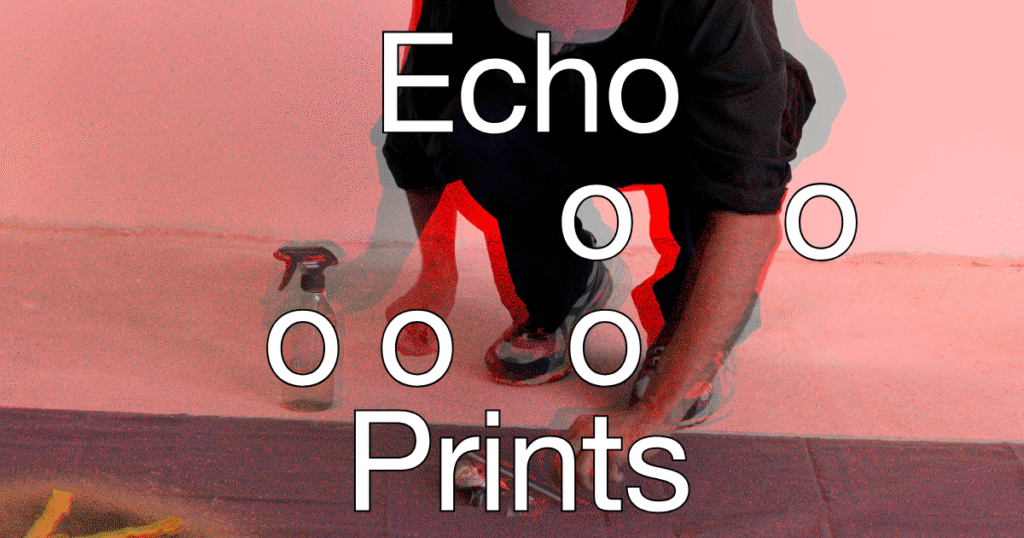
Developed within the framework of Future Fragments, Social Tablecloths explores how the future can only be sustained through shared experience and collective care. The project proposes that artistic practice can function as a method of learning — a way to rehearse and strengthen social relations through material acts.
Each workshop becomes a microcosm of community: participants bring found or discarded objects, imprint their traces on fabric, and exchange stories. In doing so, they create a collective object that embodies the values of cooperation, reciprocity, and attention. The tablecloth becomes both a practical and symbolic surface — a site where gestures of making and gestures of care overlap.
In this sense, Social Tablecloths is not only a study of sustainable materials but also of sustainable relations. It imagines the future as something co-created — a fabric woven from shared presence, mutual learning, and performative memory.
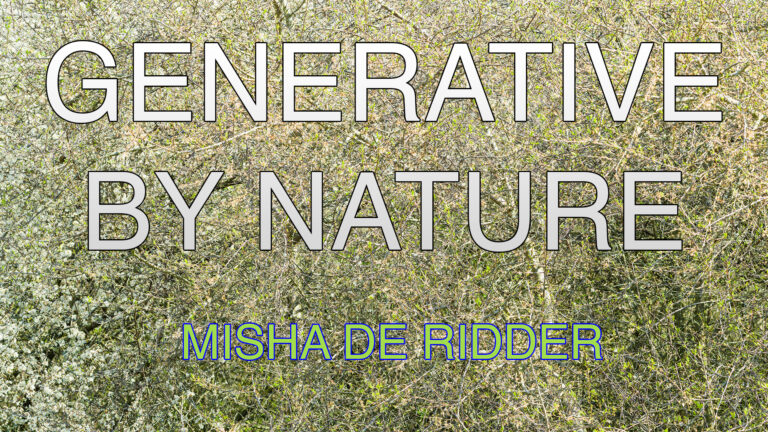









As part of the Future Fragments series, we present the project by Misha de Ridder, who photographs the moment when spring reawakens in a rewilded area of an artificial forest in the Netherlands. This place is unique — a human-made ecosystem in which nature is regaining its autonomy. The soil, trees, light, and water slowly reclaim their agency, reconfiguring the landscape according to their own unpredictable rules.
De Ridder uses photography not as a medium of aesthetic contemplation, but as an analytical instrument — a way to register a process that the human eye alone cannot fully perceive. His images do not simply document “nature”; they record the computational process of nature itself — subtle shifts in color, density, texture, and light. Each photograph is an attempt to capture movement unfolding in time — a kind of biological algorithm of regeneration.
In this sense, the series becomes not only a homage to emerging biodiversity, but also an observation of a generative system — nature as the true image-producing machine. De Ridder does not control it; he accompanies it, attuning his gaze to a rhythm in which light and matter can be read as a complex code.
Photography, in De Ridder’s work, becomes an interface between the organic and the technological. Each image marks a meeting point between two forms of intelligence: the biological and the machinic. On one side — nature, which computes, adapts, and reacts; on the other — the camera, a tool grounded in sensors, processing, and precision. This encounter is not hierarchical: technology does not dominate nature but participates in its logic, reading it with sensitivity and respect.
De Ridder photographs in an almost scientific manner — methodical, systematic, yet profoundly tender. His images testify that nature is not a static object of contemplation but a dynamic, self-transforming entity. Photography here becomes a mode of collaboration: the human does not impose, but learns to see together with the camera — and with nature itself.
The rewilded forest in the Netherlands functions as a laboratory of processes that resist easy classification. It is both natural and artificial, free and programmed, wild and precise. The same duality runs through De Ridder’s photographs — they appear organic yet result from carefully calibrated technological work: the measurement of light, time, color, exposure. The outcome is a body of images that resemble data maps, yet preserve the warmth and sensuality of a living landscape.
The photographer becomes a kind of threshold observer, standing between the natural and the digital, between perception and computation. He teaches us to see nature not as a background for human activity, but as an autonomous system — capable of creation, regeneration, and learning.
It is in this liminal space — between nature and technology — that a new sensibility emerges. A sensibility in which the camera does not merely “record” reality, but participates in its generation. Like researchers of artificial intelligence, De Ridder is interested in process rather than result. Yet unlike algorithmic systems, in his work the generative engine is nature itself — unpredictable, organic, and free from intention.
His carefully made pigment prints show intricate details and depth of field in the photographs, resulting in an immersive experience confronting the viewer with the autonomous emergent powers of the universe. The complete series also exists as a website; during the launch in spring 2022 the full collection of 36 photographs were minted on the day they were taken on the Tezos blockchain, functioning as a kind of evolving calendar during the three months of spring.








generativebynature.mishaderidder.com
In his lecture What is Intelligence? (The Long Now Foundation, 2025), Blaise Agüera y Arcas proposes that both biological and technological processes can be understood as forms of computation — systems that process information, adapt, and generate new states. In this view, nature and technology are not opposites but coexisting manifestations of intelligence distributed throughout the world.
Patricia Reed presents a lecture on AI and Alterity as Edge Detection. She explores AI as an instrument, model, and agent—from ancient myths like Talos and early systems like ELIZA, to cultural imaginaries and the political struggles shaping AI today. Reed examines how models shape concepts of “the human,” how alien reasoning emerges through AI, and how computational thought challenges traditional epistemologies. A powerful reflection on technology, imagination, and the shifting boundaries of humanity.
Patricia Reed
Artist, theorist, and designer based in Berlin. Since 2019 she has taught theory at the Design Academy Eindhoven, co-directing the master’s programme Critical Inquiry Lab since 2022. Her practice fuses philosophy, design, and speculative research, focusing on epistemology, technology, ecology, and geopolitics. Reed investigates how material and immaterial structures shape political imagination at a planetary scale. She co-authored the Xenofeminist Manifesto as part of the collective Laboria Cuboniks, a milestone in feminist and techno-critical theory. She currently pursues research in the project Figuring Planetary Space (International Architecture Biennale Rotterdam) and collaborates with the global research programme Antikythera.
Video essay by Noviki engages with the concept of latent space in machine learning, where generative models explore hidden structures and relationships within data. By simulating processes loosely comparable to human subconscious activity, it raises questions about whether algorithmic systems can exhibit creativity or intuition—not as literal dreaming, but as probabilistic computation that yields unexpected aesthetic outcomes.
Noviki is a collective working at the intersection of visual culture, speculative technology, and digital aesthetics. Their project merges AI with ecological thought, creating hybrid worlds where algorithms “dream” in organic forms. Their multi-screen, 3D installations address critical issues while delivering a strong sensory impact. Their works have been exhibited at the Museum of Modern Art Warsaw, the Krupa Foundation, and the Frankfurt Kunstverein, among others.
Dream of the Machine” was created as part of the BMW Art Club project. The Future is Art 2024 in cooperation with the Juliusz Słowacki Theater in Krakow.
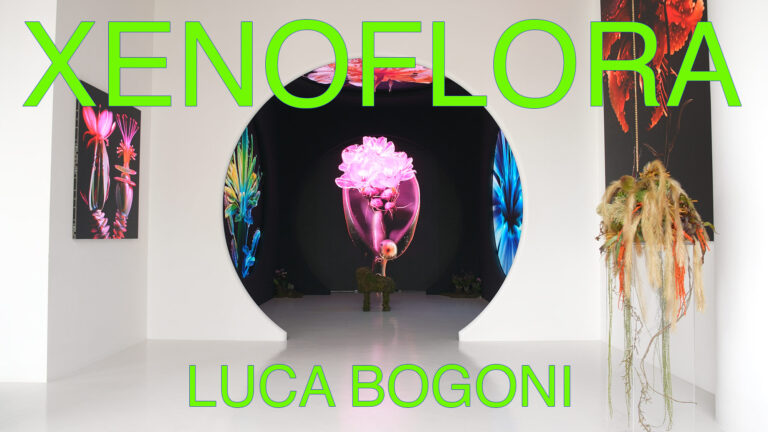
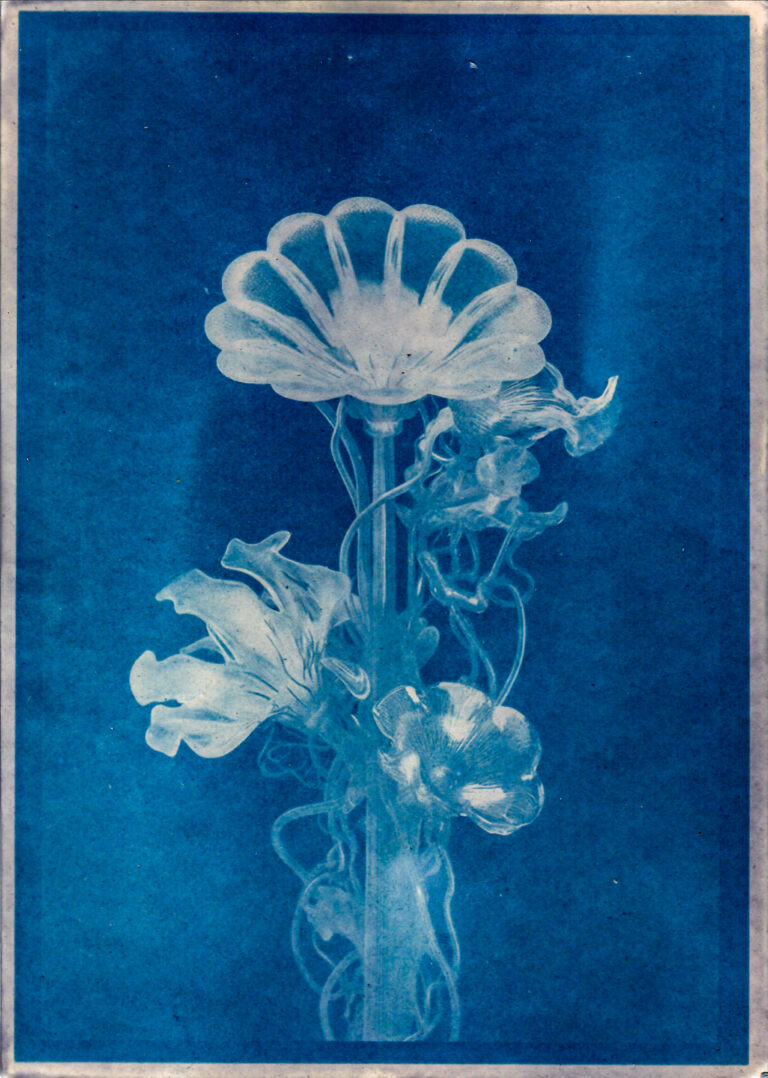

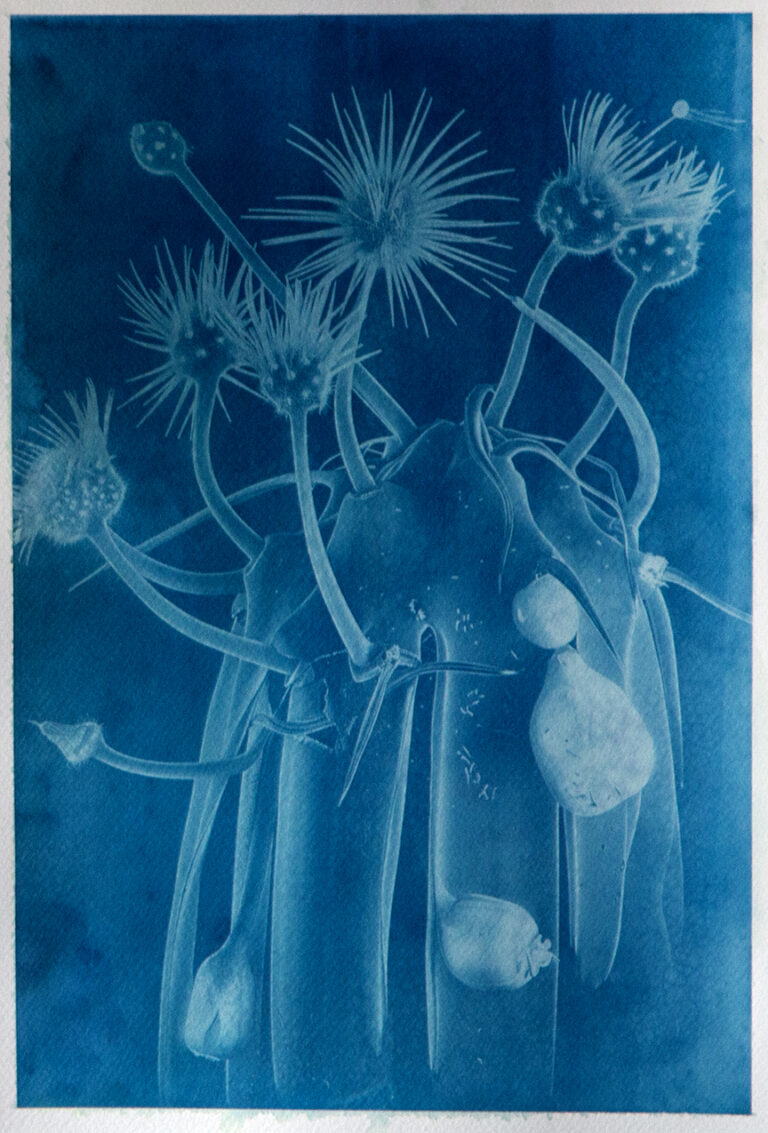
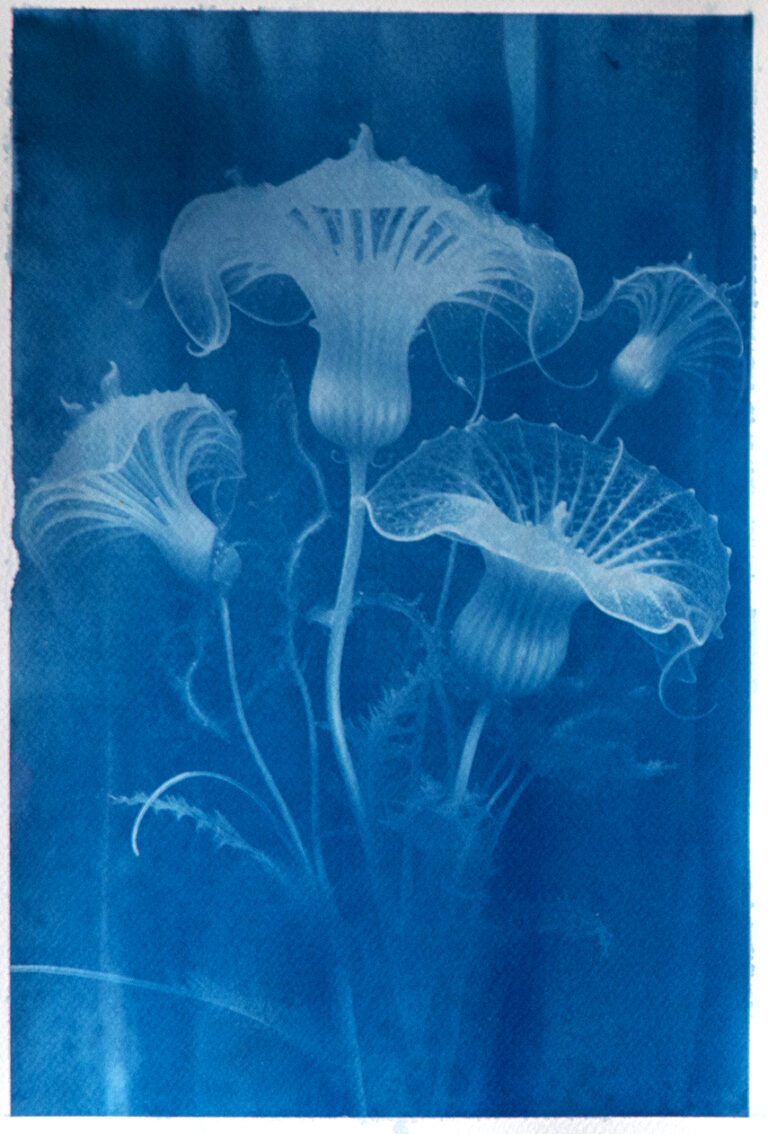





Today, in our digital world, we observe the phenomenon of neobotany, a movement that unites botanical art with advanced technology and critical reflection on the future of life on Earth.
Within this context we present the work of Luca Bogoni, one of the contributing artists to Neo Botanica, who creates cyanotypes of digital flowers. Bogoni’s practice is notable for its hybrid methodology: he merges the luminous chemistry of the historical cyanotype process with the immaterial precision of algorithmically generated imagery. By projecting digital flower forms through light-sensitive emulsions, he produces prints that are at once photographic trace and computational simulation.
This approach resonates with the intellectual legacy of early AI pioneers who sought to model organic reasoning through symbolic computation. Bogoni explores how code can emulate—and even reinvent—botanical growth patterns. His work situates plant morphology within a framework of agro-cybernetics, a field that examines feedback loops between ecological systems and machine intelligence.
Through these digitally mediated cyanotypes, Bogoni invites us to reconsider the porous boundary between nature and technology. The radiant blue prints embody both the archival permanence of nineteenth-century photographic science and the dynamic, data-driven aesthetics of twenty-first-century digital art. In the wider discourse of neobotany, his practice exemplifies how technological innovation can become a tool for ecological reflection, demonstrating that the evolution of flora—and the future of our planet—may depend on precisely such cross-disciplinary syntheses.
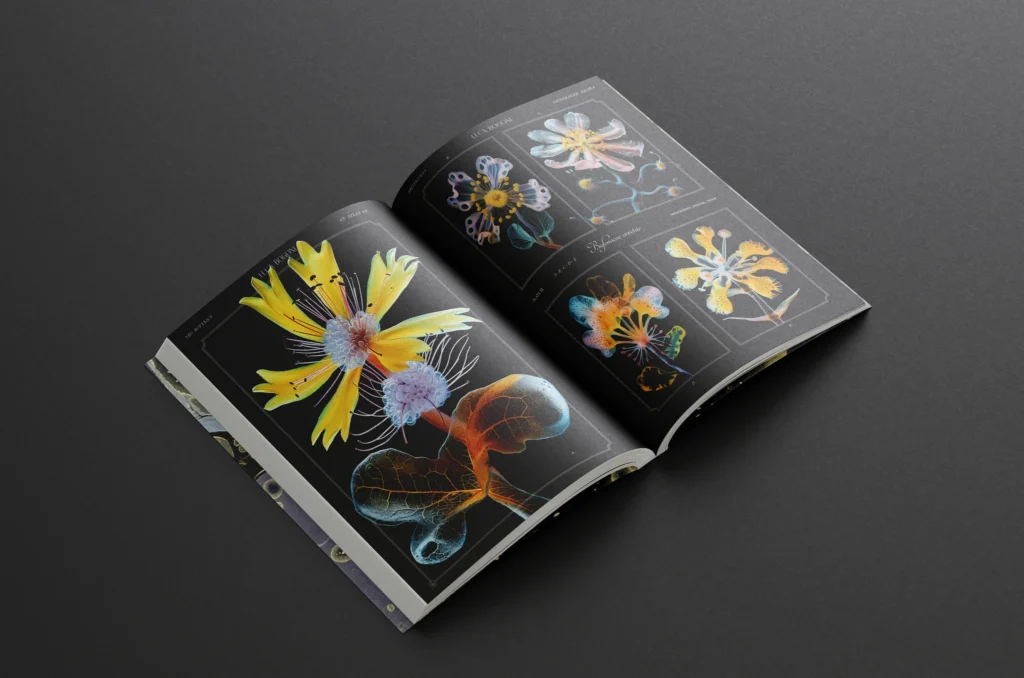
Curatorial text by Mona Schubert:
Drawing inspiration from Anna Atkins’ pioneering photographic herbarium Photographs of British Algae. Cyanotype Impressions (1843–1853), Luca Bogoni brings virtual flora into dialogue with the cyanotype process, one of the earliest photographic printing techniques.
Using AI image generators trained on real botanical imagery, Bogoni creates plant forms that, while rooted in the visual memory of actual species, exist in novel configurations that could never have occurred in nature. These images are then transferred onto transparency film and exposed to natural sunlight on hand-coated, photosensitive paper. In the early days of photography, botanists had hoped to use the medium to catalogue, preserve, and reveal the hidden structures of the natural world.
Bogoni’s works embody a tension between the artificial and the material, the objective and the imaginary. Their surfaces bear traces of two worlds: the digital imprints of AI technologies and the physical imperfections of a handmade analogue process. This encounter also unfolds in time: the near-instantaneity of machine generation contrasts with the slow chemistry of cyanotype, where images emerge only through patience and sunlight.
In this oscillation between acceleration and duration, fact and fiction, Bogoni’s images recall the Blaue Blume (Blue Flower)—the Romantic symbol of longing later evoked by Walter Benjamin as both desired and estranged. These hybrid plants become contemporary blue flowers: at once familiar and impossible, they reimagine nature as a fragile play between memory and invention.
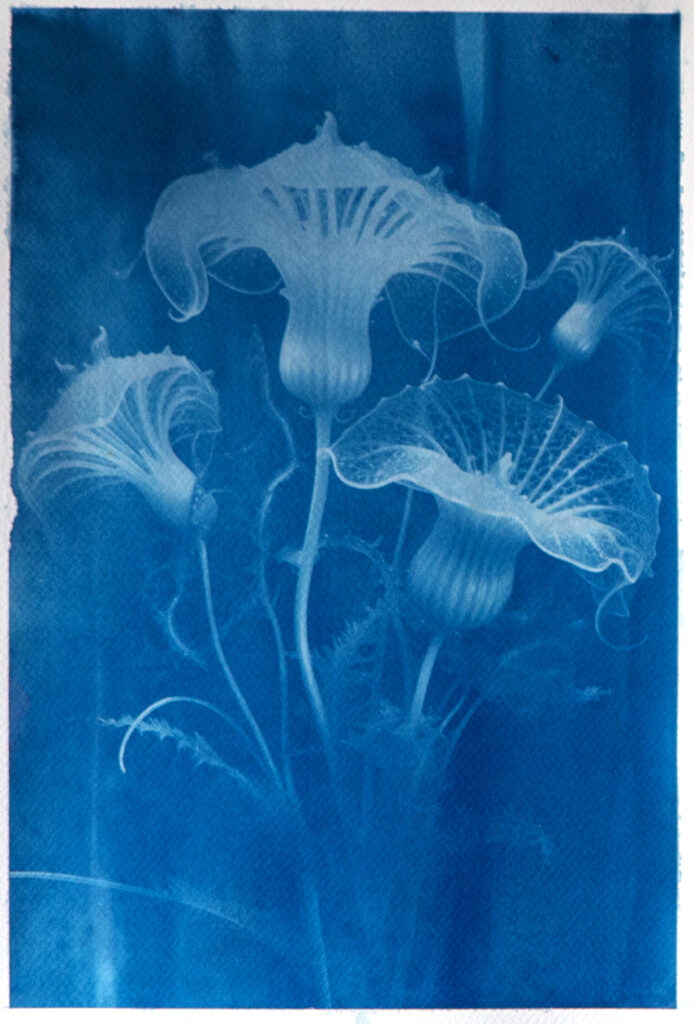
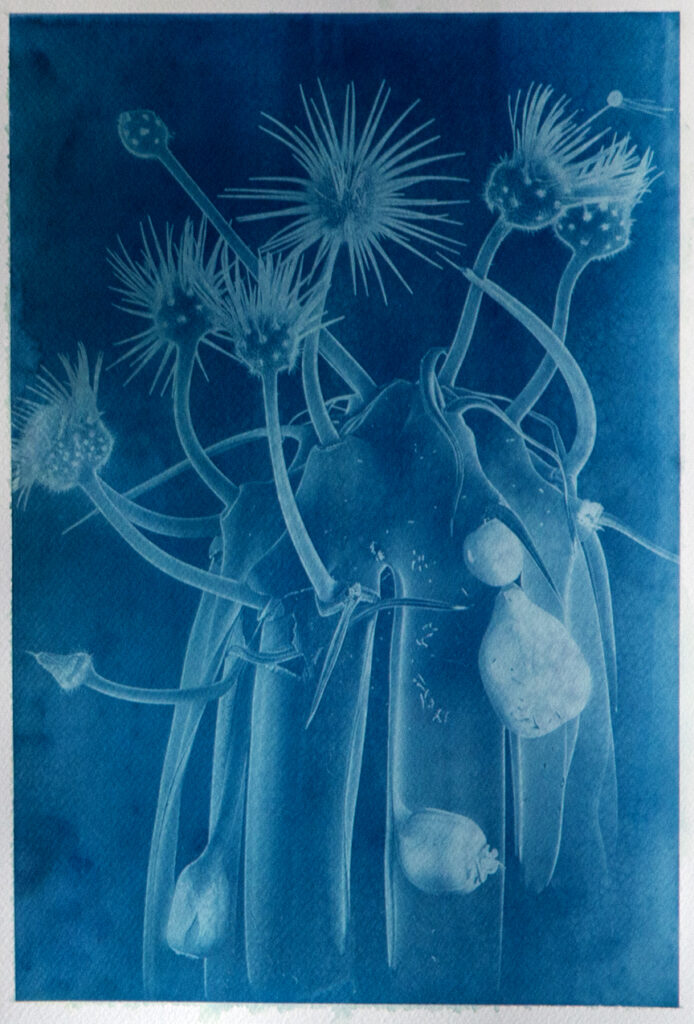
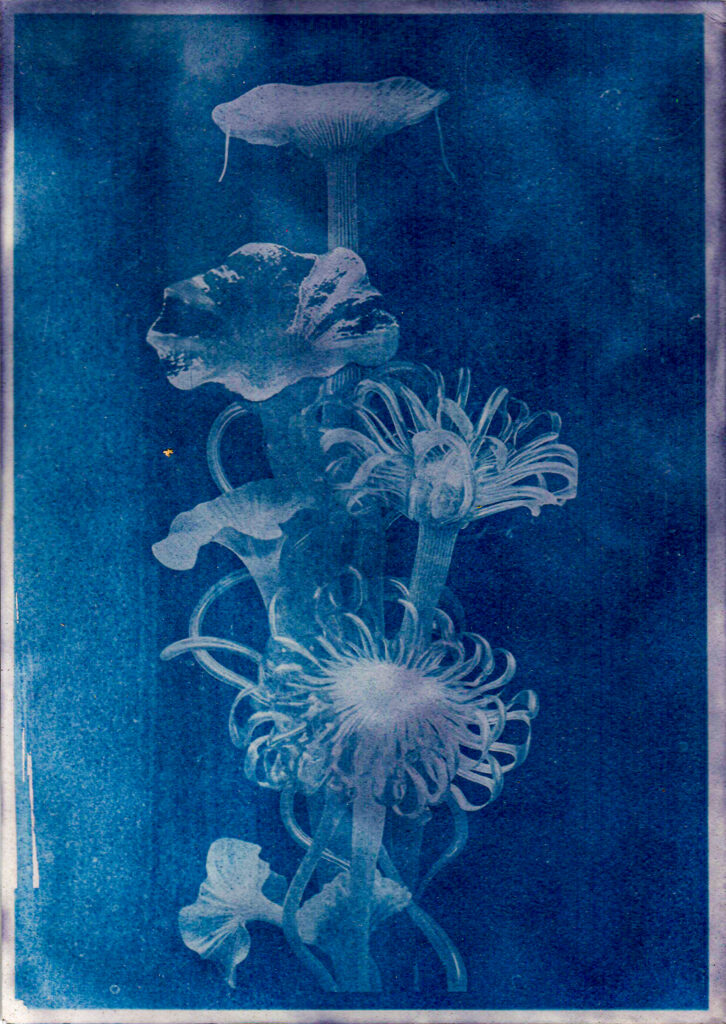
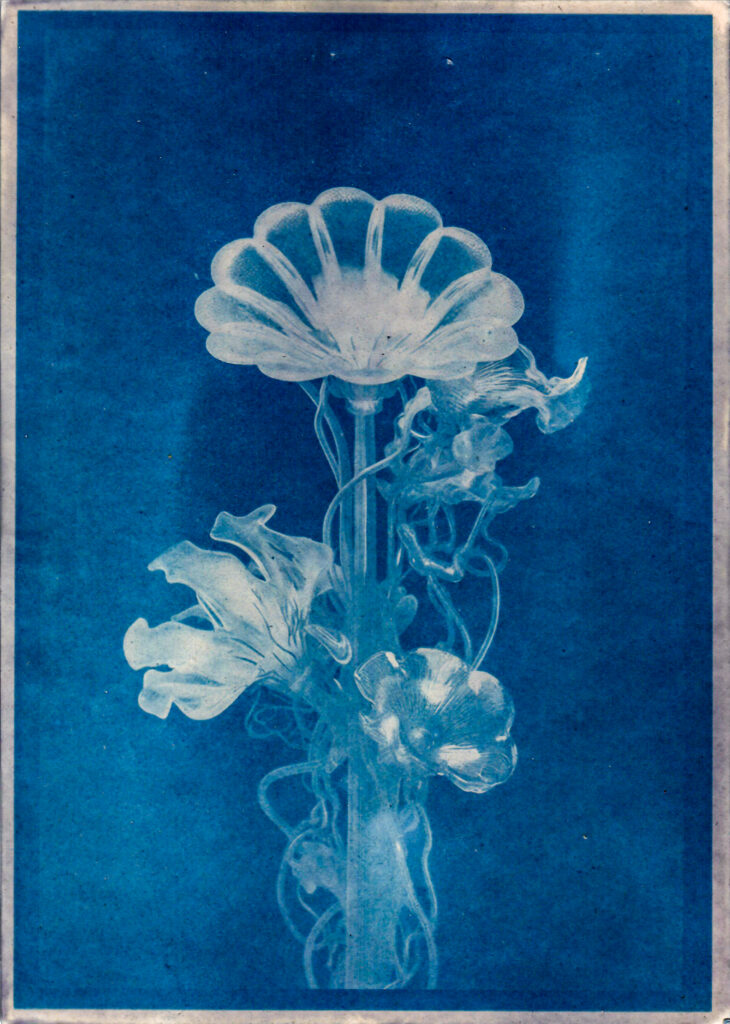

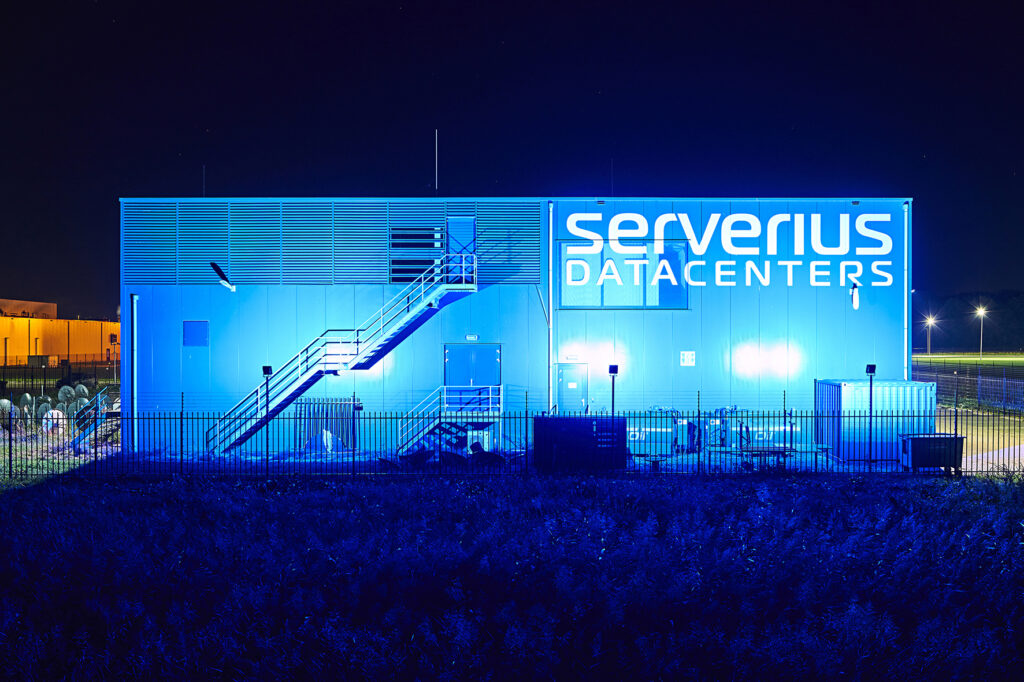




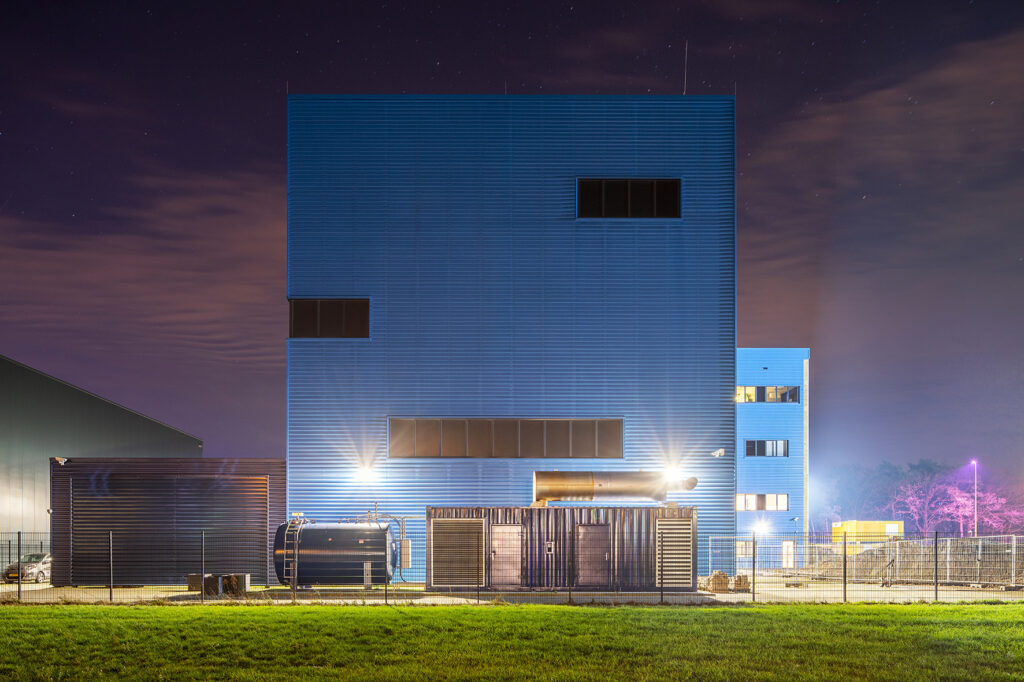




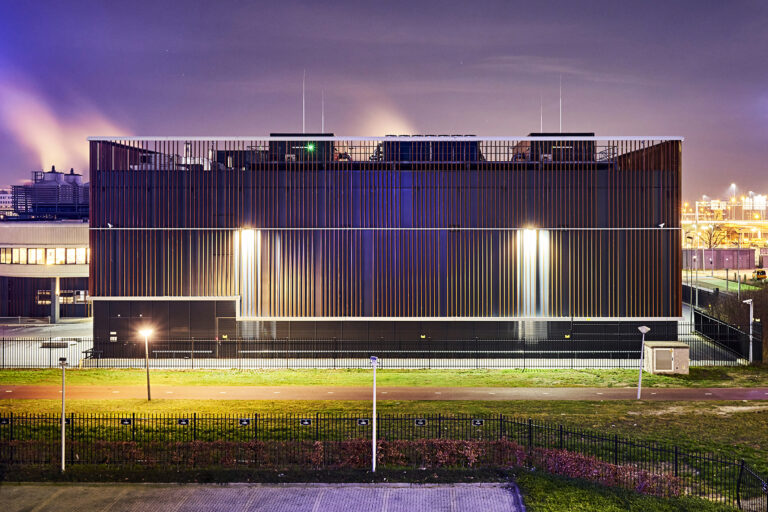
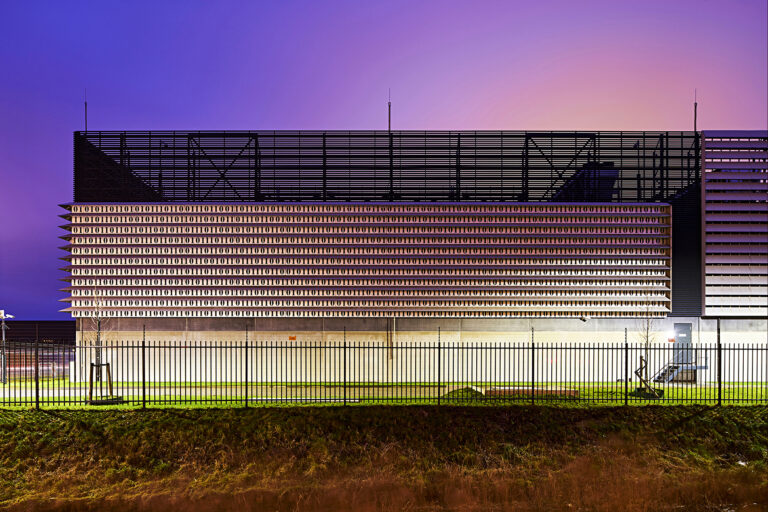
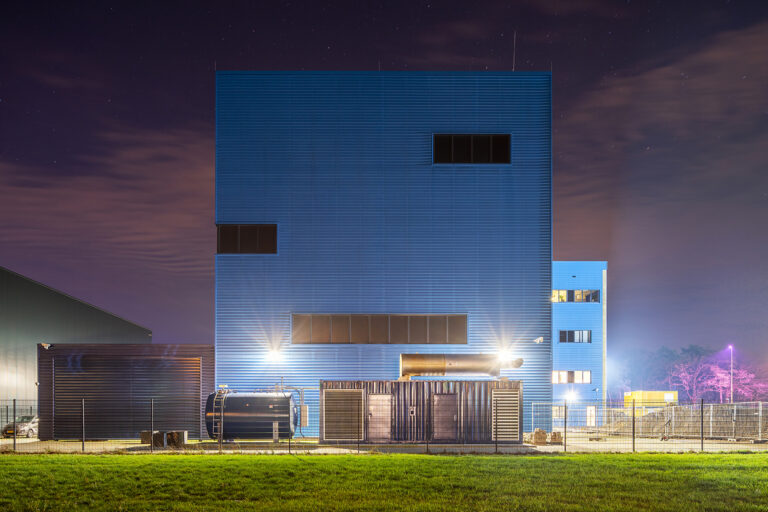
Acid Clouds: Mapping Data Centre Topologies explores the hidden infrastructures of digital life, exposing the political, ecological and social dynamics embodied by data centres. Moving beyond the sanitized image of the ‘cloud’, it unpacks the material and ethical complexities of these often overlooked data storage structures.
This interdisciplinary research and art project is accompanied by a book edited by Niels Schrader and Jorinde Seijdel. The publication brings together essays by international authors who examine data centres through diverse lenses: artificial intelligence, machine learning, digital commons, decolonial practices, technodiversity, urban strategies, environmental impact, extractivism, algorithmic bias, and digital capitalism.
A key visual component of the project is Roel Backaert’s nighttime photography of 101 Dutch data centres—monumental images that highlight their imposing yet hidden presence and prompt questions about their unseen consequences.
Acid Clouds invites us to reflect on the ethics of our digital dependencies and poses critical questions: How can data ownership and control be reimagined? In what ways do data centres shape identities and social norms? How might we resist the extractive forces of digital capitalism and envision a more equitable digital future? The project challenges audiences to critically engage with the invisible yet pervasive infrastructures that shape contemporary life.
Text contributions by Ramon Amaro & Sheena Calvert, Annet Dekker, Mél Hogan, Michiel van Iersel & Mark Minkjan, Marina Otero Verzier, Ned Rossiter, Niels Schrader, Jorinde Seijdel, Füsun Türetken, Waag (Marleen Stikker, Max Kortlander and Sander van der Waal), and photos by Roel Backaert
link to the project website: www.acidclouds.org
The Nowotny Machine is a collaborative filmmaking process that revels in uncertainty as its primary method for producing content. Drawn from the work of Austrian sociologist, Helga Nowotny and her book, “The Cunning of Uncertainty,” the Nowotny Machine is a deliberately absurd system of complex rules that co-participants must learn to navigate and decode. The machine appears systematic but deliberately avoids algorithmic thinking, forcing co-creators to confront ambiguity in their creative decisions. The resulting film emerges from this tension between structure and unpredictability, producing outcomes that could never be predetermined—a practical embodiment of Nowotny's thesis that uncertainty is not an obstacle to knowledge but a generative force within it.
The concluding debate brought together Patricia Reed, Niels Shrader, Noviki, Jakub Depczyński, and Krzysztof Pijarski, weaving their perspectives with motifs from Noviki’s Dream of the Machine, Ewelina Węgiel’s Escarpment—an experimental piece investigating regeneration, resistance, and rooted local practices—and Agnieszka Polska’s The Book of Flowers, a short sci-fi film merging AI-powered animation with 16 mm pre-production to imagine an alternative history of human–plant symbiosis across millennia, all screened at the Noorderlicht Biennial – Machine Entanglements (5–6 September 2025).
Patricia Reed highlighted the ethical and ecological stakes of AI, tracing how technological systems co-evolve with natural processes. Niels Shrader examined the materiality of machine-learning infrastructures and their environmental impact, drawing on his Acid Clouds project about data centers and atmospheric effects. Depczyński and Pijarski expanded the discussion with reflections on artistic practice, politics, and the shifting boundaries between human and machine agency.
Geert Lovink will introduce the current projects of the Amsterdam-based Institute of Network Cultures and present his forthcoming book Platform Brutality (Valiz Publishers, September 2025).
Where is platform theory today? What follows the never-ending phase of internet regression? Were you also stuck on the platform?
Lovink proposes a distinction, a dialectic between the accelerationist, violent phase of internet culture unfolding under the rise of the Elon – Trump regime, and the long-term attempt to establish a techno-feudalist economy in which “cloud rent” and enslaved users play vital roles.
How can we resist this trajectory? Can we accelerate with our stacktivist proposals to build a European digital infrastructure? Stop dreaming of sovereignty and join the Internet Core.
Geert Lovink is a Dutch media theorist, internet critic and author of Uncanny Networks (2002), Dark Fiber (2002), My First Recession (2003), Zero Comments (2007), Networks Without a Cause (2012), Social Media Abyss (2016), Organization after Social Media (with Ned Rossiter, 2018), Sad by Design (2019), Stuck on the Platform (2022) and Platform Brutality (2025). He studied politcal ande social sciences at the University of Amsterdam (UvA) and received his PhD from the University of Melbourne. In 2004 he founded the Institute of Network Cultures (www.networkcultures.org) at the Amsterdam University of Applied Sciences (HvA), which will become independent mid 2026 after his retirement. From 2007–2018 he was media theory professor at the European Graduate School. In December 2021 he was appointed Professor of Art and Network Cultures at the UvA Art History Department. He's part of support campaigns for Ukranian artists, in particular UkrainaTV (Krakow) and the related StreamArtNetwor
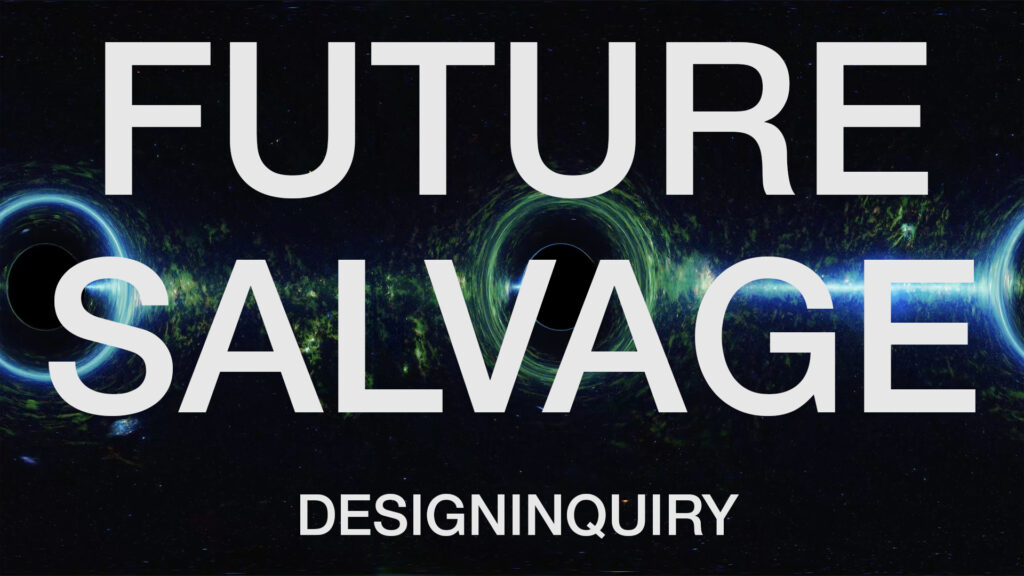
DesignInquiry and a dynamic roster of participants and activators for a week long investigation through making, contemplating, printing, binding, and collaboration!
In this context, technology plays a crucial role—as a medium of analysis, reconstruction, and innovation. It enables the creation of new methods for processing materials, digital mapping of abandoned resources, and also supports participatory processes that allow communities to co-decide what is worth reclaiming. Digital technologies, environmental sensors, AI tools, and open-source platforms can assist not only in the practical recovery of materials and spaces but also in redefining value—showing that what seems “unnecessary” today can gain new life through knowledge, collaboration, and imagination.
Future Salvage, denotes a discovery of hidden value in something dredged up from the deep, something thought to be beyond repair. As a design act, it’s a transformation, a kind of alchemy, wherein new life is breathed into abandoned things. How, then, might salvage provide an ethos and an imaginary for our futures? Can we envision the salvage of cities, of democracy, of our relations with the natural world? The port city of Amsterdam provides a perfect venue for the topic of salvage, with its history as a term used in shipping insurance, and the city’s possible futures below sea level. Aside from transforming shipping palettes into furniture or abandoned buildings into communal residences, salvage also becomes a political theory, a “craft of the poor” and a way of making that activates a protesting public. Practitioners of salvage “open themselves to the new and unseen,” according to political theorist Jason Kosnoski, who sees salvage as one of the “arts of living on a damaged planet,” in the words of Anna Lowenhaupt Tsing.
more info: futuresalvage.designinquiry.net

Future Fragments Initiative is an international art-science event taking place from September 5–6 in Groningen, the Netherlands. It focuses on the relationship between art and artificial intelligence, combining a discussion panel, artistic project presentations, and networking activities. The initiative is organized by Future Fragments and is part of a broader curatorial program. Its goal is to create a space for the exchange of knowledge, experience, and critical reflection on contemporary creative practices in the context of new technologies.
Future Bread is an interdisciplinary project by Dagna Jakubowska, founder of the Ferment House of Culture and Nature and the “New Space” Foundation. It combines culinary workshops with ecological education and artistic reflection on the future of food in the context of climate change and sustainable development. The project explores how bread of the future might look – made from local, crisis-resilient ingredients, with deep respect for nature and community.
Dagna Jakubowska – founder of the Ferment House of Culture and Nature and the “New Space” Foundation. Visual artist, theater director, producer, entrepreneur, and activist – working at the intersection of art, performance, scientific research, and social activism. In her work, she explores interspecies relationships, the politics of food, processes related to nourishment, and the politics of everyday life. In projects such as The Bread of the Future, The Edible Map of Migration, The Taste of Power: The Politics of Culinary Diplomacy, Kitchen Summit, and The Ukrainian Herbal, the kitchen becomes a political, innovative, subversive, and performative space – a place for debate and reflection on politics, economics, ecology, history, migration, and the ethics of domestic labor.
Co-founder of the social enterprise The Ferment Traveling Kitchen. Together with Aleksandra Jach and Aleksandra Hirszfeld, she co-creates the project Collective Wisdom: Cooking Up Solutions, dedicated to the practice of collective leadership.

Traces and Dirty Listening by Jonathan Castro Alejos is focused on visual and sonic practice, grounded in ongoing research into alternative/experimental ways of approaching the margin. This margin is not merely a boundary, but a charged threshold: a space beyond the circuits of urban productivity, where denial, noise, and natural forces accumulate and interact.
Working with traces, fragments, and the so-called undesirable elements of urban space becomes a method for constructing and archiving new perceptual and material narratives. This research foregrounds the unfinished and the unstable — elements through which future possibilities emerge not as smooth visions, but as layered, contested, and uneven realities.
By focusing on these overlooked dynamics, my research attempts a critical way of sensing the built environment and our relation with spaces – tracing shifting textures of time, revealing hidden layers of time, and uncovering fragments through which new visual and spatial futures may quietly emerge.
Jonathan Castro Alejos is a Peruvian multidisciplinary artist and graphic designer based in Amsterdam. Working across sound, video, installation, and performance, his practice explores the tension between the real and the imagined. Through a process of collecting, layering, and reconfiguring raw materials, he constructs immersive visual and sonic worlds. His recent release, Radiance Loops, continues this exploration—merging field recordings, lo-fi loops, and textured soundscapes into a meditative reflection on material and space.
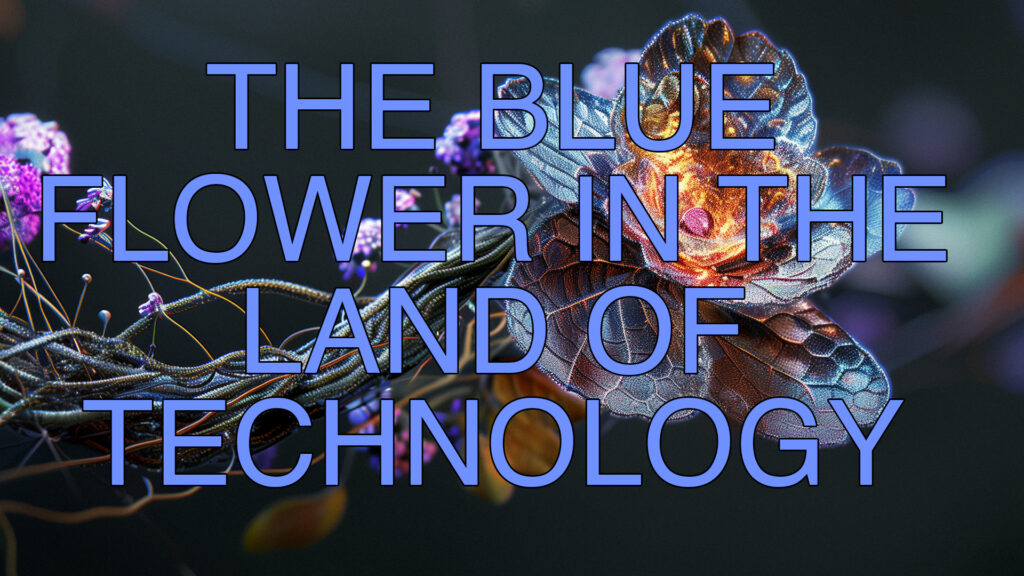
The discussion is taking place at Fotofestiwal in Łódź as part of the Future Fragments project.
The starting point for the conversation is the interdisciplinary project Dream of the Machine by the artist-designer duo Noviki, and Post-Radio by director, film producer, and AI researcher Jacek Nagłowski, inspired by Wojciech Bruszewski’s Radio Ruins of Art.
The discussion features Ada Florentyna Pawlak—an anthropologist of technology, lawyer, and art historian—and Krzysztof Pijarski, a visual artist, contemporary culture researcher, and co-founder of the Visual Narratives Laboratory at the Łódź Film School, currently a lecturer at SWPS University.
Participants:
Ada Florentyna Pawlak, SWPS University
Jacek Nagłowski, vnLab / Łódź Film School
Marcin Nowicki, Noviki
Krzysztof Pijarski, SWPS University, vnLab / Łódź Film School
More: fotofestiwal.com
The starting point for this lecture is the forthcoming book Machine Decision is Not Final: China, and the History and Future of AI and the essay by Bogna Konior included in it, Dark Forest Theory of Intelligence. The researcher introduces her talk as follows:
From Turing to Searle, thought experiments have shaped the development of artificial intelligence. In my lecture, I will present a new thought experiment inspired by Liu Cixin’s Dark Forest Theory. Contrary to Western assumptions about the transparent nature of intelligence, I propose that a truly intelligent AI may choose strategic silence, deception, or disinformation, offering a radical vision of future relationships between humans and intelligent machines.
Bogna Konior is a professor of history, culture, and the philosophy of new technologies at NYU Shanghai, where she works at the Center for Artificial Intelligence and Culture and the Interactive Media Arts department. She is also a mentor at the Synthetic Minds Lab at Medialab Matadero and a researcher at the Antikythera think tank. Her current work focuses on artificial intelligence, the history and future of technology in Eastern Europe and China, and the intersections between theology and technology.

